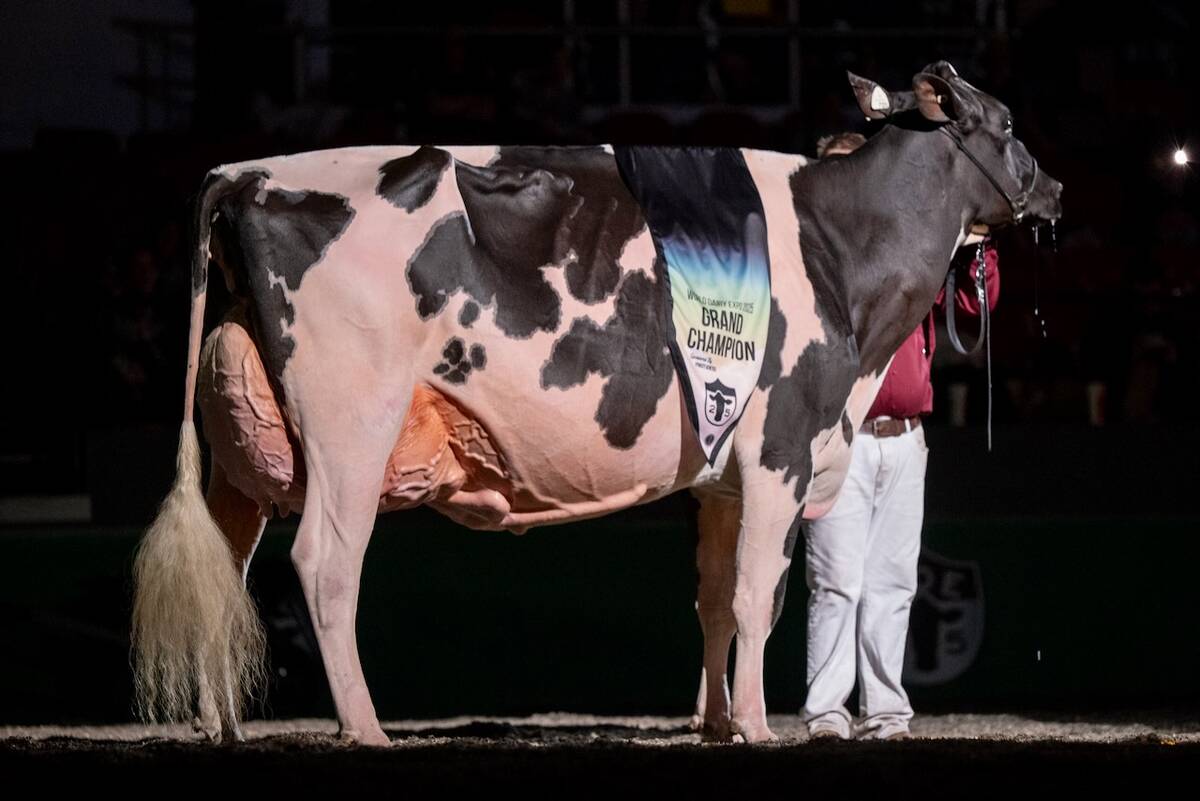Most of us are familiar with salmonella bacteria as a potential cause of gastrointestinal disease in humans. The severe diarrhea, abdominal pain, fever, headaches and dehydration can cause serious consequences in people, especially in the elderly and young children.
Salmonellosis in humans is most often associated with poultry and poultry products such as eggs. However, there are numerous strains of salmonella bacteria, and some of them are adapted to cattle.
These strains can cause significant disease in dairy and beef cattle herds as well as causing disease in people who are exposed to them.
Read Also

Canadian-bred cow wins World Dairy Expo Holstein show
A cow bred in Saskatchewan, Lovhill Sidekick Kandy Cane, is the Grand Champion Holstein at the 2025 World Dairy Expo.
People can be exposed by working with sick cattle or consuming raw milk from infected dairy cows. Salmonella outbreaks are more common in dairy herds, where animals are more closely confined, but outbreaks also occur occasionally in beef cattle operations.
Salmonella is spread by fecal-oral transmission, and the source of the infection is usually feces from infected cows.
It may be difficult to identify which cows are the source of the infection and are shedding bacteria because some infected carrier cows may show few or no symptoms and still shed as many organisms in their feces as cows that are clinically ill.
Other sources of infection may include rodents, birds, flies, cats, dogs and people.
Outbreaks are more common in the calving season.
A particular strain called salmonella dublin has recently been identified as a cause of salmonella infections in cattle in a number of areas in the world, including Europe and now North America.
I have been talking to a veterinarian on the Prairies who is dealing with a salmonella dublin outbreak in a cow-calf operation.
Salmonella dublin is a strain that has adapted to live in cattle, which remain the most important reservoir of this strain of the bacteria.
It is also difficult to treat because it tends to be multi-drug resistant and will not respond to antibiotic therapy.
Cattle, people and companion animal species can be infected by this strain of salmonella, which can lead to serious illness.
Salmonellosis is usually a disorder of the gastrointestinal tract and in cattle typically causes a fever and severe diarrhea, which is often bloody. If untreated, the diarrhea can lead to dehydration and death of the animal.
Salmonella dublin is unusual in cattle because it can also present in young calves as a respiratory illness and cause more systemic infections in mature animals, which might result in abortions in pregnant cows.
Salmonella outbreaks are difficult to control in cattle operations but especially so in the case of salmonella dublin infections. Three factors make control difficult:
- Multi-drug resistance: Antibiotics are of little value in treating clinical cases because this strain is so resistant to many commonly used antibiotics. There is some debate that antibiotic therapy may even extend the duration of the bacteria shedding.
- Ability to survive in the environment: All salmonella strains are able to survive in the environment for extended periods of time, and salmonella dublin has been shown to survive in dry feces for more than a year and in water, soil and moist areas out of direct sunlight for up to four to five years. An important aspect to controlling salmonella outbreaks is to limit the environmental exposure and avoid contaminating water sources, feed and equipment such as halters, ropes, brooms, buckets, shovels, esophageal calf feeders and nipple bottles.
- The carrier animal: Salmonella dublin is much more efficient at creating asymptomatic carriers than other strains of salmonella. Animals that undergo a period of stress such as calving may start shedding the organism again in subsequent years and cause other infections to occur. Identifying these carrier organisms is difficult, but blood tests are available at some diagnostic laboratories that may help identify carrier animals so they can be culled.
Exceptional calving management procedures must be instituted in the face of a salmonella dublin outbreak. Separating clinically infected animals from cows that are calving is essential, as is maintaining high levels of biosecurity throughout the farm.
Preventing fecal oral transmission is an almost impossible feat during calving season on most cow-calf farms, but producers will need to work closely with their veterinarians to limit the spread of this highly infectious disease.
Environmental cleanup is an important part of the control, and veterinarians can help institute a cleaning and disinfection protocol for calving areas.














